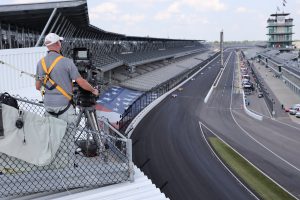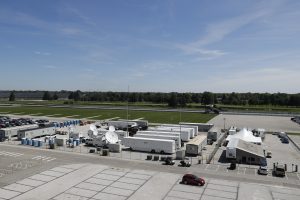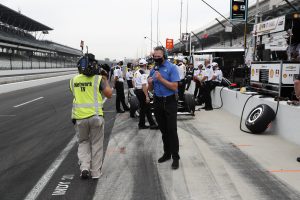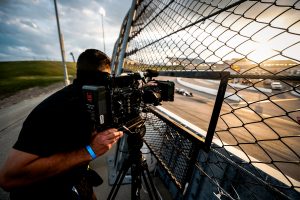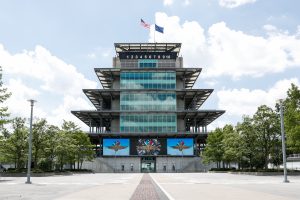Indy 500: IMS Productions Provides NBC Sports With Tech Infrastructure at Improved Indianapolis Motor Speedway
103 cameras will capture the largest sports event since the beginning of the pandemic
Story Highlights
The Indianapolis 500 is an annual pilgrimage for racing fans around the globe, and, after 2020 marked a hiccup in the yearly tradition, 135,000 fans will flock to the grounds of Indianapolis Motor Speedway (IMS) in the world’s largest sports event since the start of the COVID-19 pandemic. NBC Sports will televise its third consecutive race with the help of IMS Productions, which is providing the broadcaster with a wealth of technology, including the use of a drone for the first time and worldwide transmission of action at The Brickyard.
“We’re excited about hosting 135,000 fans,” says Kevin Sublette, president, IMS Productions. “I wish we had the full 350,000, but we’re going to take what we can get.”
Covering Every Turn: 103 Cameras Include Aerial Drone, 15 Onboards, Seven Super-Slo-Mos
Based on its massive size — IMS could fit eight famous landmarks in the infield of its 2.5-mile oval — the Indy 500 typically hosts more than a quarter of a million fans during a normal year. With so much land to cover, NBC is working in tandem with IMS Productions to deploy a fleet of 103 cameras to capture the moves of all 33 cars on the track. Topping the list is a new aerial drone, which will provide bird’s-eye views of the contest from above.
“It will be used for the pre-race and also during the race, which has never been done before,” says Sublette. During the race, the drone’s flight path will be between Turns 2 and 3, but, before and after the race, the entire facility will be in play.
“We’ve had great success with drones on other events, and Sean Owens is an exceptional young director with great ideas,” says Sam Flood, executive producer/president, production, NBC and NBCSN. “He’s going to work it in and make sure the camera has the quality and the look that takes us to the next level. The one hard part about drones is, they’re not up in the air for a very long time. They’re up in spurts, where he has to time out when he wants to [deploy] it. Does he want to do it for a restart? Does he want to do it for pit stops? It’s a bit of a math equation, but it certainly is going to be beneficial in building the hype.”
Along with the drone’s debut at Indy, an age-old classic will be back at the track: onboard cameras. IMS Productions recruited the assistance of BSI to handle the RF services for the devices, which will be installed on 15 cars — an increase of one from the 2019 Indy 500. Lastly, the race will also use seven super-slo-mo cameras around the track for chances at engaging video replays.
In the Compound: Live Coverage With Two Trucks, Safety Protocols
Each year, IMS Productions pulls off an impressive task with a smaller-than-usual crew. This year, a total of 125 staffers will be onsite for Sunday’s festivities. As for the mobile units they’ll be working out of, the compound will look a bit different from previous years.
“Pre-race is going to come out of our HD3 truck, which will then throw to the main truck, HD5, for the race,” says Sublette, “and we’ll stay in that truck for all of the post-race ceremonies. It’s a little bit smaller footprint, probably the smallest footprint in terms of mobile units that we’ve ever had for the Indy 500.”
All camera feeds will be controlled from this location, which will also feature a handful of other technologies, including 85 channels of tape recording and 15 operators working with 17 EVS replay servers.
RF capabilities will be provided by two additional trucks dedicated to BSI.
Although COVID-19 cases are declining and vaccinations are available, IMS Productions is prioritizing crew safety. In accordance with Marion County medical officials, crew members are still required to wear face coverings and follow other health guidelines. In addition, two separate production “annexes” have been constructed to host staffers and ensure social distancing.
“We have one annex that has EVS operators and another to control the 10 robos that will be used,” Sublette explains. “We’re still maintaining at least a 3- to 4-ft. zone around each person, making sure we’re changing out the MERV filters regularly, and not allowing people to go into other mobile units unless they have a purpose to be in there.”
Connecting the trucks in the compound to the venue is a bit of a laborious task, and, after 145,000 ft. of Tac 12 fiber was laid for last year’s race, cabling will be increased to 225,000 ft. this year.
“Since we own all of the fiber,” Sublette notes, “we’re responsible for deploying, maintaining, and bringing it back to the trucks the day after the race.”
A Race for the World: International Feed Grows to 29 Broadcasters in 209 Countries
U.S. auto-racing aficionados always have the date of the Indy 500 circled on their calendar, but there are passionate fans of the sport outside the U.S. as well. For those looking to get their IndyCar fix for a race on the grandest of stages, IMS Productions is supplying a robust world feed.
Within the television compound, a comprehensive plan calls for the signals from IMS to be sent to SES in Hawley, PA, for distribution to 29 broadcasters in 209 countries. The number of broadcasters and countries has been expanded from last year, and IMS Productions is tasked with producing even more international coverage.
“In the past, [the world feed] has always been done only for the race,” says Sublette. “Now we’ve included the last practice of the weekend, qualifying, and the race. Afterwards, we actually produce a cutdown highlight hour show [of the race] that’s sent out on Monday morning for those who want to have that as a replay.”
Support From Stamford: Remote Staffers Pitch In for Pre-Race Show
Remote productions and implementation of cloud-based workflows have ramped up since early last year. These practices have been effective on other productions, but, for the large-scale endeavor taking place this weekend, race coverage will rely mostly on the work of crews in the compound. However, NBC Sports director Mike Sheehan and his team will be supported by a pair of colleagues working remotely from the broadcaster’s home facility in Stamford, CT,
“NBC Sports has two graphics operators in Stamford that will work with the [onsite] producers,” says Sublette. “We have KVM and AT&T Fiber to connect everything back to Stamford and will also have our C- and Ku-band trucks onsite as backups for both of them.”
Remote solutions will not be the only unusual aspect of this year’s pre-race show. IndyCar drivers are known for pushing the limit, but, before the cars travel around the track at high speeds, Red Bull will be dazzling in-person fans and TV viewers alike with a competitive diving race in the air. Four jumpers will descend over the track and fly through gates suspended from four separate parachutes before the winning team lands first on the inside of Turn 1. The stunt will be facilitated by 3G Wireless, which is onsite working in a truck provided by Gravity Media to link camera feeds between the helicopters, jumpers, and the team on the ground.
Venue Enhancements: Pagoda Plaza Media Board Keeps Fans Up-to-Date
Prior to the pandemic, racing titan Roger Penske finalized the purchase of Indianapolis Motor Speedway and IndyCar in January 2020. Since then, he has concentrated on improving the amenities and infrastructure of auto racing’s crown jewel. One of the improvements is a 102- by 20-ft. media board installed on the Pagoda prior to last year’s race. Ross Video’s Unified Venue Control Solution powers the more than 47 LED displays in the track’s interior, and its XPression Tessera, Carbonite Mosaic, and DashBoard control platform drive graphics and image processing on this new display in Pagoda Plaza. Throughout the weekend, especially on race day, fans walking the premises will, for the first time, have updated information from NTT on the three-board display.
“They’ll have primary program feed, timing and scoring, iso feeds of driver on-boards, and a customized visual data presentation from our series sponsor NTT,” says Sublette. “I’m able to step outside my trailer in the compound and read it perfectly.”
Overall, the work done by Penske over the past year has elevated productions and the fan race-day experience. As one of IndyCar’s most notable figures, this weekend will mean a lot to Penske, who has contributed immensely to the sport.
“This used to be a diamond in the rough,” says Sublette. “Now it’s a diamond, because of his attention to detail. From bathroom colors to curbing, there’s nothing out here that he hasn’t touched, and he has done an incredible job.”
Collaborative Effort: All Facets of IMS Unite to Bring Back Storied Spectacle
Throughout the years, it has been proven that, whether fans are in the stands or not, the Indy 500 is a very long and busy day for IMS Productions and the host broadcaster. Furthermore, it has been a hectic year full of last-minute adjustments that extend beyond the television production.
“The ticketing office deserved massive kudos because they’ve gone through scenario after scenario,” says Sublette. “We were originally going to have 50,000 fans, and then they opened it up to 135,000 fans, so they had to redo their entire system. It has been a huge undertaking for them.”
Now IMS Productions will get the chance to enjoy the return of fans and the proper pageantry, buzz, and celebration that can be evoked only by the Indianapolis 500.
“The big thing for us is having the fans back,” says Sublette. “It was an eerie feeling to host the Indy 500 in August without people in the stands, so we’re really excited for this year’s race.”
